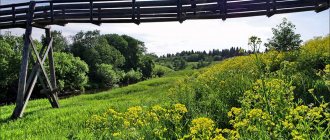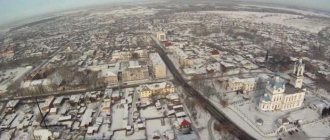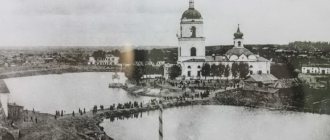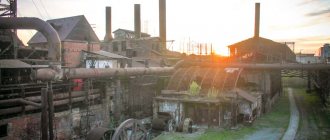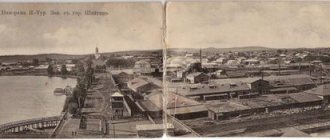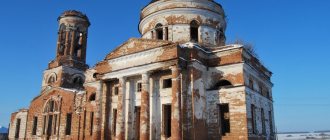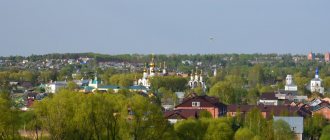History and sights of Chukhloma
Continuation of the story about the journey through the Kostroma and Vologda regions along the old Arkhangelsk route from Moscow to Totma. Having said goodbye to Galich, we moved on. Chukhloma was waiting for us ahead. I don’t know about you, but for me the name of this city used to be associated exclusively with the expeditionary raid in the Kostroma wilderness “Full Chukhloma”. From Moscow - only 450 kilometers in a straight line. But this is a completely different world, with its own passage of time.
Village in the distance
As we moved north, villages became less and less common, and the forests became denser. There were practically no oncoming or passing cars. The quality of the road surface is average. The shadows lengthened noticeably: time was inexorably approaching sunset.
Hills
We entered the Chukhloma district.
Village with dilapidated houses
Deserted road Road towards Chukhloma
Chukhloma appeared. We left the road and turned towards the city center.
Chukhloma
The first written mention of Chukhlom dates back to 1381, but archaeological evidence indicates that a settlement in this area existed already in the 10th century, on the site of the current Avraamiev-Gorodetsky Monastery - a little away from the city. Today the population of Chukhloma is just over 5,000 people.
Entering Chukhloma Typical two-story wooden houses Svoboda Street
Almost all houses in Chukhloma are wooden. Many people have firewood piled up in front of them. I wonder if there is a main gas supply here? No characteristic yellow pipes were observed.
Firewood dumped near one of the houses
We parked in the very center, on Revolution Square, where ancient stone houses that belonged to the Chukhloma nobility before the revolution have been preserved.
Klimov House, 1916-1917. Nowadays there is a civil registry office and the Chukhloma Museum of Local Lore. The Church of the Assumption of the Blessed Virgin Mary, 1723
Houses in the center of Chukhloma
In the 15th-16th centuries in Chukhloma, on the high bank of the Sandeba River, a wooden fortress in the shape of an irregular quadrangle was built. It burned down during the “great fire” in 1727. Earthen ramparts up to 4 meters high have survived to this day.
Chukhloma Center
Teahouse of the Bolshakov merchants, mid-19th century. Nowadays the Beryozka Hotel
And we decided to go down the steep street to Lake Chukhloma.
Street leading to Lake Chukhloma One of the streets in Chukhloma
Lake Chukhloma is quite large. In the distance you can see the Intercession Avraamiev-Gorodetsky Monastery, located in the village of Nozhkino. It was founded at the end of the 14th century by the Monk Abraham of Gorodetsky, a disciple of Sergius of Radonezh. Representatives of some noble families, including the Lermontovs, are buried in the monastery.
Chukhloma Lake and Avraamiev-Gorodetsky Monastery
Chukhloma is an interesting place! But we still had a way to go.
Rise of Chukhloma Memorial stone in honor of the 600th anniversary of Chukhloma and a monument to Lenin Houses in the center of Chukhloma Chukhloma Chukhloma Old wooden house
Having left Chukhloma, we stopped in thought. Either go straight to Soligalich, or, after spending an hour, make a detour to Astashovo, where the miracle tower stands. To be continued…
© Website “On the Roads of the Middle Way”, 2009-2021. Copying and reprinting of any materials and photographs from the site anashina.com in electronic publications and printed publications is prohibited.
Chukhloma: where the old roads lead
The old people say that it is on the eve of dawn, in the darkest hour of the night, that what is hidden behind the veil of broad daylight can appear to a person. This very predawn hour can be considered the usual pre-winter period, which generously dumps everything that is hidden behind the summer foliage and in the thickets of green grass. Therefore, apart from muddy roads and rising rivers, October and November are a wonderful time for trips into the wilderness. To see what once breathed life.
By a happy coincidence, it was in mid-October that the removal of forests from the Astashovsky tower, which stands in the Chukhloma wilderness and which we wrote about here, fell. Therefore, we went to the Kostroma wilderness for two days, booked a hotel in Galich and planned the second day. Saturday morning was promising. This is the sunrise we watched over the Volga while driving along the edge of the coast to Yuryevets.
Fields of harvested stubble added the color of old gold to the morning.
Apart from the stop in Kineshma for refueling, the first cultural stop happened in Zavolzhsk. How long can you drive past? There are wonderful points of interest there - the mansions of the former owners of the chemical plant, the Burnaevs - the Kurochkins. And the houses stand very close - on the edge of the Volga bank. The first manor house of the Burnaev-Kurochkins was built no earlier than 1908-1909. It is built of red brick, in which you can see the influence of the so-called “factory style”; the brick walls are left unplastered, that is, they have the appearance and masonry typical of industrial buildings. The house has two floors and a tower, shaped like the “Romanesque towers” of the early Middle Ages. The tower is crowned with a high tent (its wooden structures previously reached a height of 11 m, now - 2.5 m).
From the description of the house it is known that on the ground floor there was an office, a dining room, a sleeping room, and a hall. From the dining room there was access to the veranda. On the second floor there were two large halls and an office. The basement housed a servant's room and utility room.
Now the building houses the museum of the city of Zavolzhsk. This is what the house looked like before.
Its neighbor is the current House of Culture, a later home of the owners of chemical production facilities. During the First World War, chemical plants worked for military orders, which brought profit and required the expansion of production. The young architect Viktor Vesnin, who together with his brother became the founder of constructivism, was just working on the building for the second chamber system for the production of sulfuric acid at the Burnaev chemical plant. The owner is ordering a new house for him. So, right next door to the old one, a new mansion appears, which is called “an excellent example of neoclassicism of the early 20th century. The protruding 4-column portico under the triangular pediment is raised by the front porch, the side facades are decorated with semi-rotundas, and above the roof is the dome of the front hall. It's a pity that the palace looks shabby.
And before, the house looked happier.
By the way, the mansion of the mayor of Sirotkin on the Verkhnevolzhskaya embankment, familiar to all Nizhny Novgorod residents, is also Vesnin’s work. Two merchants who lived above the Volga were lucky to have an architect
